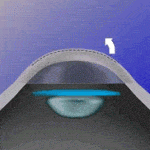Fortified LASIK Eye Surgery

If you are looking to be lessen the burden of eye glasses or contact lenses there are several options to help you. In the past most people with vision issues had to rely on glasses or contact lenses to get the vision they desired, however there have been many changes and improvements when it comes to vision correction.
While recent treatments including traditional LASIK procedures, not all people are good candidates and it often causes disturbances in the patient’s vision after the procedure is performed. Luckily now there are new alternatives. One procedure, known as Fortified LASIK, is an advanced form of the traditional LASIK procedure which also includes an accelerated version of Dr. Brian’s patented Holcomb C3-R corneal crosslinking. This treatment helps to strengthen the cornea and helps to extend the longevity of the LASIK procedure results
Below you will find more information regarding the Fortified LASIK procedure and you can make the choice for yourself.
Fortified LASIK Eye Surgery:
Fortified LASIK accommodates those that have somewhat thinner cornea or slight irregular shape, because it strengthens the cornea right after the procedure.
Fortified LASIK is only available at the Boxer Wachler Vision Institute. Dr. Brian developed this procedure to increasing the longevity and safety of the LASIK.
May people searching our LASIK in Los Angeles have found Dr. Brian’s procedure to be comfortable and effective in providing visual freedom.
Below are some of the benefits of Fortified LASIK Eye Surgery:
- Can improve overall quality of vision
- Can improve night vision
- Can achieve 20/20 vision (in some cases)
- Quick recovery
- Repairs some cornea distortions
- Can replace or reduce the need for your glasses or contact lenses
- Strengthens the cornea and reduces risk of developing Ectasia
Clear and precise quality of vision is important in our everyday lives, for both work and personal reasons. Ask a friendly patient concierge about the Fortified LASIK procedure. For more information regarding Fortified LASIK.
Watch this clip from the Emmy award daytime talk show The Doctors:


